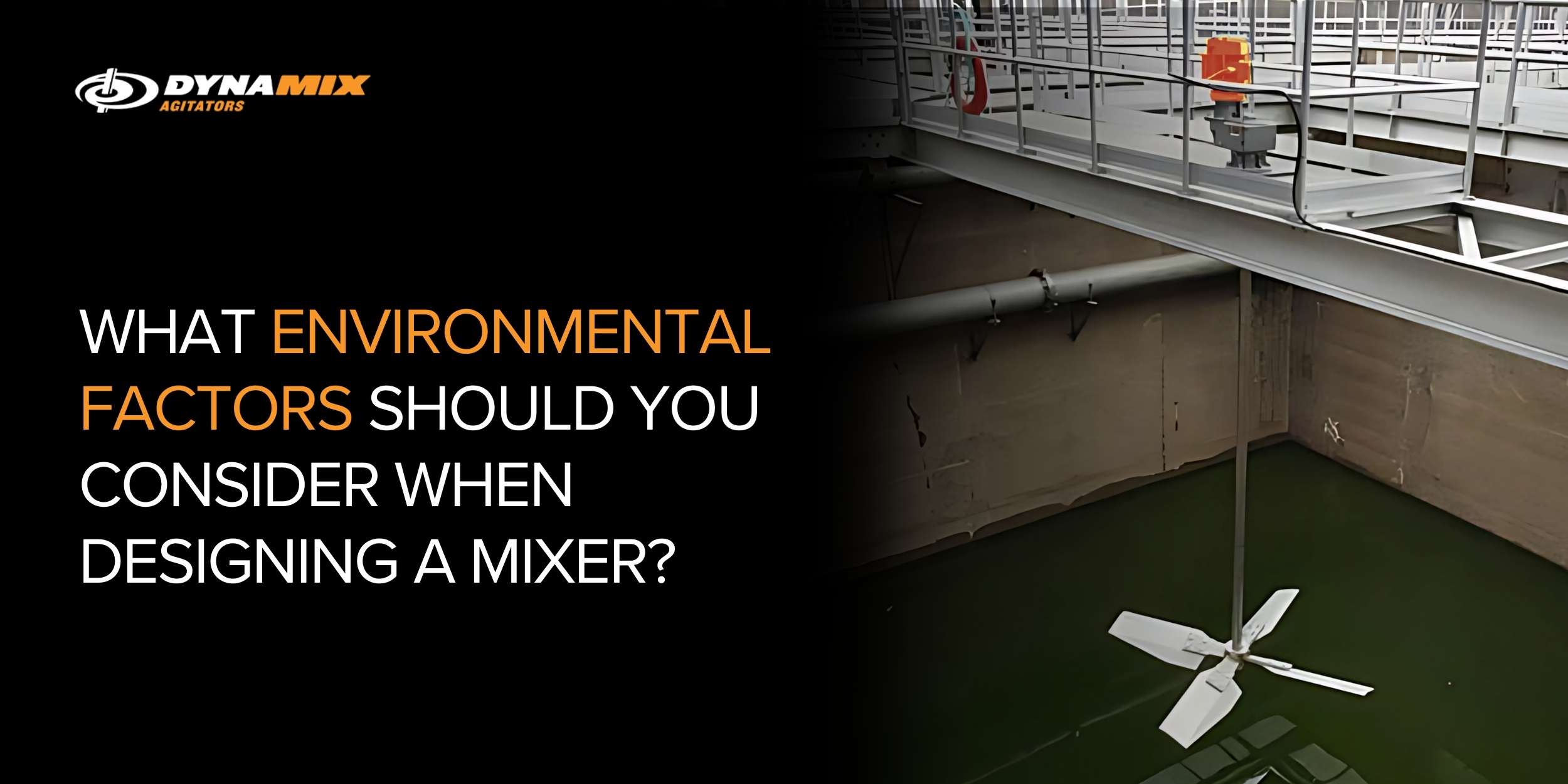- Q: Why do environmental conditions matter in mixer design?
A: They affect durability, safety, and performance. Failing to consider them can lead to equipment failure or safety risks.
- Q: What are the most common environmental challenges for mixers?
A: Temperature extremes, chemical exposure, pressure conditions, humidity, and explosive atmospheres.
- Q: Can mixers be customized for outdoor use?
A: Yes. Weatherproof enclosures, UV coatings, and sealed components are commonly used.
Environmental Factors To Consider When Designing a Mixer
Why Environment Matters in Mixer Designs
In the industrial mixing world, choosing the right mixer is about more than just capacity or motor size. One of the most overlooked aspects of mixer design is the environment in which it will operate. Environmental conditions affect equipment lifespan, energy efficiency, safety, and ultimately, product quality.
When engineers select mixers for high- and low-temperature environments, the conversation quickly moves beyond horsepower, torque, shear and impeller type. In the real world, it’s the materials and seals that make-or-break performance. And those lessons weren’t learned in sanitized labs, they were forged in the mills, mines, and refineries of North America, where Dynamix was born.

From frozen Canadian wastewater lagoons to the caustic digesters of the Pacific Northwest pulp industry, we’ve seen what works, what fails, and why. Here’s a deep look at how material choices align with industry and temperature, and why rugged experience matters.
Whether mixing in extreme heat, under pressure, or in chemically aggressive environments, every detail matters. Understanding these factors helps engineers configure mixers that can endure the elements and perform reliably over the long haul.

Best Practices for Mixer Selection in Challenging Environments
Seal selection is not one-size-fits-all, it’s industry and temperature dependent. At high temperatures, mechanical and metal bellows seals dominate, while at low temperatures and ambient service, stuffing boxes, lip seals, are often preferred. The industries that push seal technology hardest are oil & gas, chemicals, mining, pulp & paper, water treatment, and pharmaceuticals, each with its own mix of challenges.
1. Oil & Gas / Petrochemicals (High Temperature & Pressure)
- Conditions: Elevated pressures, hydrocarbons, corrosive gases, and temperatures that can exceed 300 °C.
- Seal Types:
- Mechanical seals with hard face materials (silicon carbide, tungsten carbide).
- Metal bellows seals for high-temperature thermal stability.
- Gas-lubricated seals in refineries where product leakage must be minimized.
2. Chemical Processing (Broad Temperature Range)
- Conditions: Highly corrosive acids, bases, solvents; temperatures from cryogenic (-100 °C) up to +260 °C depending on process.
- Seal Types:
- Stuffing boxes or lip seals in low-pressure, low-temp duties.
- Mechanical seals with exotic metallurgy and PTFE or graphite packing for high-temp corrosives.
3. Mining & Mineral Processing (Abrasive, Often Hot Slurries)
- Conditions: Abrasive slurries (phosphates, copper, gold tailings), often at elevated temps from grinding or chemical leaching.
- Seal Types:
- Stuffing box seals with Kevlar/graphite packing for rugged service.
- Cartridge mechanical seals with hardened faces and flush plans to prevent abrasive ingress.
4. Pulp & Paper (Hot Caustics, Moderate Pressure)
- Conditions: Hot alkaline pulping liquors, bleaching chemicals, temperatures up to 180 °C.
- Seal Types:
- Mechanical seals designed for caustic resistance.
- Hydraulic seals and heavy-duty packing where leakage is less critical.
- Why critical: Avoids seal failure in batch digesters and mixing tanks.
5. Water & Wastewater Treatment (Low Temperature, Variable Solids)
- Conditions: Ambient to slightly elevated temperatures, abrasive grit, biological solids.
- Seal Types:
- Simple lip seals or stuffing boxes where leakage is acceptable.
- Split mechanical seals in retrofits for ease of maintenance.
- Why critical: Keeps equipment running reliably in municipal and industrial clarifiers, digester mixers, and aeration systems.
6. Pharmaceuticals & Biotechnology (Low to Moderate Temperature, Sterile Conditions)
- Conditions: Sterile or aseptic mixing, CIP/SIP environments, often 0–150 °C.
- Seal Types:
- Double mechanical seals with barrier fluids for sterility.
- Why critical: Prevents contamination while tolerating temperature swings during sterilization cycles.
Just like seals, material selection is temperature-dependent across industries. At high temperatures, exotic alloys (Inconel, Hastelloy, titanium) and hard seal faces dominate. At low temperatures, toughness and chemical compatibility (316L stainless, PTFE, FRP) matter more. The industries that push material science the hardest oil & gas, chemicals, mining, pulp & paper, water treatment, and pharma each rely on carefully chosen materials to survive temperature extremes and chemical attack. Corrosive environments quickly degrade unprotected equipment. Mixer design must consider the chemical profile of the process fluid and ambient air.
Dynamix wasn’t built on theory. It was built in the heavy industries of North America, where mixers are pushed to the limits of heat, cold, abrasion and chemistry. In those environments, survival doesn’t come from standard catalog designs it comes from a culture of engineering and customization to develop and source the right components for the job.
Infoneva’s Knowledge Base provide excellent coverage on the impact of ambient humidity on drive performance.

How Dynamix Customizes Mixers for Environmental Resilience
At Dynamix Agitators, environmental factors are integral to the mixer design process. Each application is assessed for operating conditions, chemical exposure, and installation challenges. Common customizations include:
What to expect when working with us for for Mixer Selection in Challenging Environments
Always gather full process specifications, including worst-case environmental scenarios.
Select and discuss materials — exposure expectations.
Validate compliance with industry-specific standards.
Include serviceability in remote or outdoor locations.
Work with us to rationalise your worst, so we can supply resilience
Conclusion: Designing Mixers for the Real World
The most effective mixers aren’t just technically sound—they’re environment-ready. That’s why every Dynamix mixer is configured with resilience in mind. We don’t just supply a motor and shaft — we engineer the entire system to match the environment:
- Motors & Gearboxes selected for altitude, thermal stability, torque, duty cycle, and much more.
- Materials of Construction (MOC) chosen to resist corrosion, abrasion, or stress cracking in hot caustics, sour crude, or freezing sludge.
- Protective Coatings & Linings applied where aggressive slurries or chemical attack would otherwise eat through steel.
- Lubricants & Bearings specified for extreme temperatures, from subzero Canadian winters to refinery process heat.
- Seals & Elastomers matched to pressure, temperature, and chemical compatibility — never “off the shelf” if the environment demands more.
The result is a mixer configuration optimized for environmental resilience and long-term uptime, not just initial specs. Whether it’s in the oil sands of Alberta, pulp mills of the Pacific Northwest, or Mineral Processing in Arizona, Dynamix mixers are built by sourcing and integrating the best components available to meet each industry’s unique temperature and chemical challenges.
That’s the difference when you work with Dynamix: we don’t just build mixers, we build solutions that last where others fail.
Take a look at the different mixer options we have on our Dynamix website or send a Request for Quote form directly to one of our Application Engineers and we will get back to you right away.
FAQ's

Environmental Factors To Consider When Designing a Mixer
Why Environment Matters in Mixer Designs In the industrial

Mixing Non-Newtonian & High-Viscosity Fluids: Strategies for Shear, Temperature & Rheology Control
Understanding the Complexity of Non-Newtonian and High-Viscosity Fluid Mixing Mixing

Industrial Mixing System Design 101: Impeller Size, Vessel Geometry & Shear Dynamics
Why Understanding Mixing System Design Is Crucial Industrial mixing
Other Recent In The Mix Articles:
Search :
SELECT THE BLOG CATEGORY BELOW
Categories
- Coal Mining (1)
- Crop Protection (1)
- Dynamix Products (7)
- Explosion Proof Motors (1)
- Fertilizer Mixer (1)
- Hand Sanitizers (1)
- Industrial Mixing (51)
- Mechanical Seals (1)
- Mining & Mineral Processing (1)
- Mixer Configuration (25)
- Mixing 101 (23)
- Mixing at Home (5)
- Mixing Principles in Play (9)
- Oil & Gas (1)
- Tank Configuration (4)
- Tote Mixing (2)
- Update (1)
- Water Treatment (28)
- Water Treatment Books (6)
- Water Treatment Innovation (13)
WHAT OUR CUSTOMERS ARE SAYING
Keep up with what's new at Dynamix
Subscribe to our newsletter for helpful technical publications and industry announcements.


